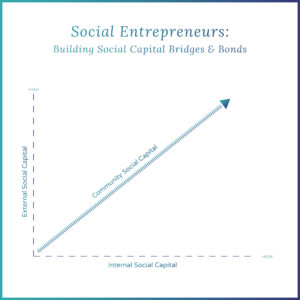Loneliness continues to increase in workplaces and communities, with 40 percent of American adults experiencing feelings of loneliness (Murthy, 2018). Many who are employed, including CEOs, report feeling the same way. Thankfully, governments are not standing idle; numerous countries are examining loneliness and searching for solutions. The United Kingdom, for instance, is working to address the problem through the creation of the position of Minister of Loneliness, whose responsibility it is to “use all the levers that we have in government to try and connect people together” (John, 2018).
A decline in our sense of community isn’t anything new. In 2000, renowned scientist and National Humanities Medal–recipient Professor Robert D. Putnam outlined the distressing state of our communities in Bowling Alone: The Collapse and Revival of American Community. Since the book’s publication, statistics have continued to support a diminishing state of civic engagement. Labor unions continue to weaken, as participation currently stands at a mere 10.5 percent (Ivanova, 2019). Although millennials are a bright spot, volunteering has dropped among Americans to one in four (n.d., 2018). In Putnam’s new book, The Upswing, rekindled calls for social capital, or a shift from me to we, continue, for which workplaces and communities are responsible. Social capital is essential—and social entrepreneurs may drive its collective value.
Defining Social Entrepreneurship and Social Capital
Before exploring how the two concepts connect and serve to offer possible solutions, it is necessary to define social entrepreneurship and social capital. Whereas social entrepreneurship is, in simple terms, business conducted in support of a social cause, this definition doesn’t come without nuance. A largely undisputed element is the focus of social entrepreneurs on the “primacy of social benefit,” according to Getting Beyond Better: How Social Entrepreneurship Works, in which coauthors Roger L. Martin and Sally R. Osberg highlight how social entrepreneurs alter equilibriums. Whereas traditional business and government can be restrained in mission, social entrepreneurs have the flexibility to remove the constraint of a profit-only focus in business and a governmental aim to please as many people as possible. Social entrepreneurs, therefore, tackle societal challenges in unique and potentially disruptive ways.
Defining social capital is more straightforward. Social capital is not about one individual or one individual’s network. According to Putnam, social capital represents a connected community. In these relationship connections, trust is an essential social capital component, as is a sense of mutual obligation and responsibility and some evidence of reciprocity.
Social capital is further delineated by two types: bridging and bonding. As implied, bridging reaches outside typical networks and extends to a diverse group, and bonding relates to the quality of the relationships involved. While bridging social capital increases the number of connections to individuals and institutions, bonding creates a depth of trust to these connections (Engbers et al., 2018). As such, social capital is—appropriately so in strong networks, relationships, and connections—multidimensional.
How Social Entrepreneurs Are the New Social Capital Builders
With social entrepreneurship and social capital defined, social entrepreneurship can start its work of decreasing loneliness. Social entrepreneurs upset equilibriums and span organizational boundaries, by their very nature building bridges to other entities and diverse individuals. The good news is that social entrepreneurship is on the rise, with half as many start-ups adopting a social or environmental mission as opposed to one that is purely commercial in nature (Groom, 2018). Social entrepreneurship may also disrupt generationally, with 86 percent of millennials believing business should function as a force for positive social impact. Social entrepreneurship only seems to grow in importance.
The challenge, then, is how to enable more social capital where social entrepreneurs work and reside. With a decline in community-centric organizations and connections, social entrepreneurs have an opportunity to increase social capital through collaborations and in how they enable their organization to increase the depth and breadth of these connections. Social entrepreneurs can build social capital from within their organization while increasing social capital in the communities they serve. Indeed, both efforts are required for social entrepreneurs to be successful social capital builders.
Building Social Capital Internally
Within any organization, collaboration builds relationships and establishes trust, both of which are necessary in social capital and social entrepreneurship (Kwon et al., 2013; de Bruin et al., 2016). Social capital originates within an organization and requires CEOs to play a role and set an example. CEOs can facilitate the building of social capital through the sanctioned exploration of ideas and in discussing initiatives with diverse individuals and teams (Cao et al., 2012).
Social capital relies on more than any single person, however. To build social capital within organizations, CEOs need to purposefully establish intersections in which individuals can collaborate and build relationships. Forming distinctive relationships within a company requires people to experience someone else’s talent and the results of that talent. When new relationships form, social capital grows. Increased social capital in turn boosts innovation. Give-and-take reciprocity emerges that allows individuals to meet freely and solve problems or develop new initiatives (Baker et al., 2011).
Social capital is also shared, which is why a CEO can accelerate social capital through example but cannot serve as the sole instigator. If social capital becomes wholly reliant on the CEO as the central point, it will ultimately diminish. In my personal start-up experience, the CEO, to their credit, spent a significant amount of time discussing programs and ideas with various individuals within the company. Over time, however, all of the CEO’s ideas required his approval before any associated work could move forward. For this reason, the natural reciprocity to build social capital between team members eventually decreased.
Therefore, social capital is as valuable within a company as it is external to the company. Leadership can initiate the social capital process, but the key to constructing the platform is to empower bonding between team members. As these bonds develop, social capital gains momentum and greater shared responsibility and positive results occur. Social capital becomes valued—infectious, even—within a company.
Building External Social Capital
When social capital is healthy in a company, employees’ organic extension of the benefits throughout the greater community will occur. Social entrepreneurs embrace social benefits, which translates into societal action, but it takes purposeful and committed engagement to build social capital within communities.

CEOs can once again set the example by bridging social capital through the development of relationships with other companies’ executives and various community leaders. Gaining innovative insight happens when a CEO develops diverse relationships outside the company (Cao et al., 2012). Since connections work both ways, social capital builds within the community through the social entrepreneur’s increasing mutuality with others.
Social Entrepreneurs: A Call to Build Social Capital
Social entrepreneurs upset equilibriums, and community engagement is in dire need of agitation. More so than disruptors, social entrepreneurs are poised to serve as the new hope for renewed social capital within companies and communities. Lessons about social capital can be easily learned and effectively supported within a social enterprise—the conversion of these lessons into community action is the vital element. When this tangible shift occurs, the social entrepreneurial firm gains innovative insights and is better positioned as an organization equipped to harness this newfound wisdom. Equally important to the internal benefits are the social capital examples evident in the external community.
Social entrepreneurs invest in improving society and do so without sacrificing the organization’s financial sustainability, both of which require social capital. Any effort to increase engagement and decrease loneliness may seem natural, but conscious effort is required to craft a company’s social capital platform. From this foundation, extending social capital into the communities provides fulfilling engagement while offering social entrepreneurs a source of innovation—a win-win in any social capital–centric community.
Sources
Baker, E., Onyx, J., & Edwards, M. (2011). Emergence, social capital and entrepreneurship: Understanding networks from the inside. Emergence: Complexity and Organization, 13(3), 21-38.
Cao, Q., Simsek, Z., & Jansen, J. J. P. (2012). CEO social capital and entrepreneurial orientation of the firm. Journal of Management, 41(7), 1957–1981. https://doi.org/10.1177/0149206312469666
de Bruin, A., Lewis, K. V., & Shaw, E. (2016). The collaborative dynamic in social entrepreneurship. Entrepreneurship & Regional Development, 28(3–4), 310–311. https://doi.org/10.1080/08985626.2016.1140429
Engbers, T. A., & Rubin, B. M. (2018). Theory to Practice: Policy Recommendations for Fostering Economic Development through Social Capital. Public Administration Review, 78(4), 567–578. https://doi.org/10.1111/puar.12925
Groom, B. (2018, June 15). A third of start-ups aim for social good. www.FT.com. https://www.ft.com/content/d8b6d9fa-4eb8-11e8-ac41-759eee1efb74
Ivanova, I. (2019, January 21). Union membership in the U.S. hit record low in 2018. CBSNews.com. Retrieved from https://www.cbsnews.com/news/union-membership-declined-in-2018/
John, T. (2018, April 25). Meet the world’s first loneliness minister. Time. Retrieved from https://time.com/5248016/tracey-crouch-uk-loneliness-minister/
Kwon, S.-W., Heflin, C., & Ruef, M. (2013). Community social capital and entrepreneurship. American Sociological Review, 78(6), 980–1008. https://doi.org/10.1177/0003122413506440
Martin, R. L., & Osberg, S. R. (2015). Getting beyond better: How social entrepreneurship works. Harvard Business Review Press.
Meet the generation that volunteers the most. (2018, January 11). Up with People. Retrieved from https://upwithpeople.org/uwp-blog/meet-generation-volunteers/
Murthy, V. H. (2017, September). Work and the loneliness epidemic. Harvard Business Review. Retrieved from https://hbr.org/cover-story/2017/09/work-and-the-loneliness-epidemic
Putnam, R. D. (2000). Bowling Alone: The collapse and revival of American community. Simon & Schuster.
Putnam, R. D., & Garrett, S.R. (2020). The upswing: How America came together a century ago and how we can do it again. Simon & Schuster.


[…] Mertz of Thin Difference shared Social Entrepreneurs Are the New Social Capital Builders. Jon considers: "Social entrepreneurs disrupt, and our internal and external engagement practices […]